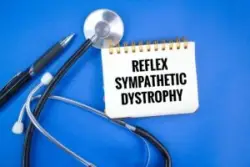
RSD Symptoms and Treatment Lawyer Austin
The causes of Reflex Sympathetic Dystrophy, commonly referred to as Common Reflex Pain Syndrome (CRPS), are not yet known. It is believed that the damaged nerves send signals to the brain that interfere with normal information about sensation, temperature and blood flow. Anecdotal evidence suggests that early treatment is helpful in limiting the length and severity of CRPS, but there are no clinical studies as yet to back up that hypothesis.
In addition, there are no comprehensive diagnostic tests to determine the presence of CRPS. It is incumbent on the physician to assess the subjective complaints of the patient along with documenting the objective findings of the injury to reach a diagnosis of CRPS.
For a free legal consultation, call 800-863-5312
Symptoms will often include burning pain, extreme swelling, increased sweating, muscle spasms, softening of the bones, joint tenderness and stiffness, difficulty with movement and changes in the nails and skin. CRPS will often start in an arm or a leg and then spread throughout the entire body. One very visible sign of CRPS is warm, shiny red skin that later turns cool and bluish in color.
Call or text 800-863-5312 or complete a Free Case Evaluation form







